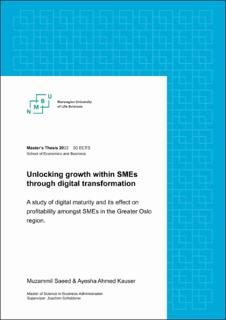| dc.contributor.advisor | Scholderer, Joachim | |
| dc.contributor.author | Saeed, Muzammil | |
| dc.contributor.author | Kauser, Ayesha Ahmed | |
| dc.coverage.spatial | Norway, Oslo | en_US |
| dc.date.accessioned | 2023-01-03T12:57:45Z | |
| dc.date.available | 2023-01-03T12:57:45Z | |
| dc.date.issued | 2022 | |
| dc.identifier.uri | https://hdl.handle.net/11250/3040656 | |
| dc.description.abstract | Small and medium-sized enterprises (SMEs) classify as the very backbone of Norwegian business and industry. According to SSB, there were a total of nearly 630 000 active enterprises operating in Norway in 2022 (SSB, 2022). This constitutes more than 99% of all companies in the country. The SMB-market also account for half of the value creation in the country. On the other side, we see that these companies have a great need for a digital competence boost which is an important driver for innovation and competitiveness. Their path to becoming more digital, in context with lack of economic capital, fewer employees and minimal resources, is an interesting topic in itself. It has previously been proven through research that digitization in large companies is profitable. Unfortunately, there is little research on the same topic regarding the SME market.
The purpose of this master’s thesis is to shed light on whether there is any significant correlation between digitalization and financially profitable for small and medium-sized companies. This is done through qualitative interviews with 30 top leaders from companies in the greater Oslo, who participated in the study. The main aim is to evaluate their digital and technological implementations made in the time period 2014-2019, which is the period the study is based on. Furthermore, these implementations are sorted based on the functions marketing, logistics, organization / management, and production, based on the conceptual product that has been developed by the authors. This conceptual product quantifies the company's digital maturity by quantifying it through a digital index. The economic profitability ratio Return on Sales (RoS), which denotes the relationship between operating profit and turnover, are the parameter used to measure whether the implementations are profitable or not.
The result of the study shows that digitization does not necessarily have a significant connection with profitability. This means that implementation that is introduced does not show any improvement in the financial results even five years after the digital implementation has been introduced. On the other hand, implementations in the organizational / management function are an exception. The findings from the study show that a digital implementation leads to financial profitability 3 years after it is implemented. This thesis explains favorable digital implementations for SMEs, and why some are insufficient in achieving their desired goals where the effect has been negative. | en_US |
| dc.description.abstract | Små og mellomstore bedrifter (SMB) klassifiseres som selve ryggraden til norsk næringsliv. Ifølge SSB er det i 2022 til sammen nærmere 630 000 aktive virksomheter i Norge (SSB, 2022). Dette utgjør mer enn 99% av alle bedriftene i landet. Disse står også for nærmere halvparten av verdiskapningen i landet. Allikevel ser vi at disse virksomhetene har et stort behov for et digitalt kompetanseløft som er en viktig driver for innovasjon og konkurransekraft i Norge. Dette sett i sammenheng med lite ressursintensitet og mangelen på økonomisk- og humankapital. Det har tidligere blitt bevist gjennom forskning at digitalisering i store virksomheter er lønnsomt. Dessverre er det lite forskning rundt same tematikk som gjelder samme tematikk i SMB-markedet.
Hensikten med oppgaven er å belyse om det er noe signifikant sammenheng mellom digitalisering og økonomisk lønnsomt for små og mellomstore selskap. Dette blir gjort gjennom kvalitative intervju med 30 toppledere fra selskap i Oslo og Viken som deltok på studiet. Disse forteller om deres digitale og teknologiske implementeringer gjort i tidsperioden 2014-2019, som er den perioden studien baserer seg på. Videre blir disse implementeringene sortert basert på funksjonene markedsføring, logistikk, organisasjon/ledelse og produksjon, basert på det konseptuelle produktet som har blitt utviklet av forfatterne. Dette konseptuelle produktet kvantifiserer bedriftens digitale modenhet med en gjennom å tallfeste en digital indeks. Dette ses på i sammenheng med det økonomiske lønnsomhetsfunksjonen driftsmarginen, som betegner forholdet mellom driftsresultat og omsetning.
Resultatet av studiet viser at digitalisering av de samtlige funksjonene ikke har en signifikant sammenheng med lønnsomhet. Dette betyr at implementering som blir innført ikke viser noen bedring i de økonomiske resultatene selv fem år etter at den digitale implementeringen har blitt innført. Derimot så er implementeringer i organisasjons/ledelse funksjonen et unntak. Funnene fra studiet viser at en digital implementering fører til økonomisk lønnsomhet 3 år etter at den er iverksatt.
Denne oppgaven gir implikasjoner på hva som er gunstige implementeringer. Det redegjøres også for hvorfor implementeringene bedriftene har gjennomført ikke har klart å nå sitt ønskede formål. | en_US |
| dc.language.iso | eng | en_US |
| dc.publisher | Norwegian University of Life Sciences, Ås | en_US |
| dc.rights | Attribution-NonCommercial-NoDerivatives 4.0 Internasjonal | * |
| dc.rights.uri | http://creativecommons.org/licenses/by-nc-nd/4.0/deed.no | * |
| dc.title | Unlocking growth within SMEs through digital transformation : a study of digital maturity and its effect on profitability amongst SMEs in the Greater Oslo region | en_US |
| dc.type | Master thesis | en_US |
| dc.description.localcode | M-ØA | en_US |

